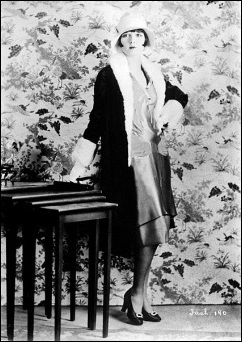
Louise Brooks in 1927, from the George Grantham Baine Collection LC-B2- 5474-15
One does not make the mode - one submits to it. Many unpremeditated circumstances may combine to start it - no one can say whence it came. There is no doubt that this or that individuality may give to it, by intelligence or taste, a new impulse. Were it possible to discover its origins, it would be found that different elements, having no connection with one another, had come together at its birth. In order that this or that may be approved, it is essential that some well-known lady, whose reputation for elegance is well established, and whose position is such that she can permit herself innovation, should herself be sufficiently taken by the idea to consent to express it in her toilette.
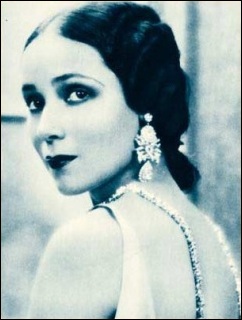
Dolores Del Rio from Stars of the Photoplay
By the middle of 1920 skirts had crept up again, showing at least six inches of ankle. The hair was still worn bobbed and girlish immaturity was the correct pose. It was at this period that sport had its first direct influence upon fashion. Suzanne Lenglen in a straight, sleeveless frock vanquished her opponent, who was still faithful to skirts, shirts and petticoats. It has taken some years for this sporting influence to spread, but today it permeates our whole wardrobe.
The year 1921 gives us our first example of the uneven hem line. The exotic note increases - skirts are longer, sleeves are ornate and of immense importance, waists are recognizedly long, oriental colours are favoured and barbaric earrings, with sleekly brushed heads, make their appearance.Head-dresses of swathed tulle and gold tissue are seen at premieres, while on summer days the new organdie in lemons and blues make the smartest frocks for Ascot.
Our 1923 lady has lengthened her skirts a trifle and hides her ankle. During this year we see square cut bodices, sustained by narrow shoulder straps, open at the sides, and girdled at the hips with ornate jewelled belts. Perhaps a couple of pale orchids are tucked into the belt on the the left side. The very long earrings are a characteristic note of this year also.
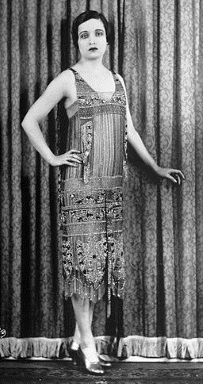
Alice Joyce in 1926, from the George Grantham Baine collection LC-B2- 6504-8
Starting in 1924, a curious change started taking place in the designation of gowns. Instead of a morning frock or afternoon frock, as the hour might be, dresses were designed to fulfill a certain purpose. For instance, something for shopping, something for traveling, for a formal dinner, and, now that everyone was dancing, something for foxtrotting. Every dress had its special metier.
A charming example of a dance frock of the year 1925 was one worn by Miss Annette Mills, the well-known dancer. The straight and easy fitting bodice which folds lightly round the waist is allied to a full skirt with a slightly circular movement, cut in large scallops at the hem, and adorned with big flat applique flowers in shining tissue. There is a quaint little trimming of the glittering tissue, outlining the neck and armholes and side seams of the bodice, and hanging in two dangling ends from the front of the decolletage. The whole thing had such a simple elegance, and is so airy in its transparent fabric, that nothing could be more charming for dancing. The skirt is quite short, though covering the knees by some inches.
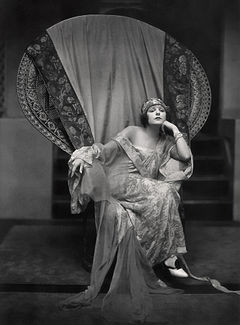
Norma Talmadge 1922
The dignity of the bride was not forgotten in this modern hey-day rush for simplicity. Some brides chose mediaeval lines for their wedding gowns; cloth of gold also had its vogue. Hair had passed from bobs to shingle and Eton crops, so that special attention had to be paid to the bridal head-dress. The pointed front of Russina inspiration was found to be generally becoming, especially after Worth had made for a bride one with a trellised tiara of pearls across the brow over a lace scarf draped capwise, with bunches of orange blossom and trailing bands over the ears. A sweeping veil of tulle falling from the nape of the neck held by an bandeau of orange blossoms.
Evening wraps again became matters of extreme importance in 1926. The airy grace of chiffon made it an ideal medium for dance frocks in this year. Imagine a lovely black dancing dress like a starry night, with its diamante edgings and designs. A slender-fitting bodice which reaches to the hips, where the full uneven flounce hang softly to cover the knees, is cut to sway at the front and sides to show a pale underdress, similarly adorned with diamante. An ample soft fur coat serves as an admirable foil to the frosted darkness of the dress.
The bolero or zouave line in the Spanish manner over a very full skirt that rippled and fell with every movement became a picturesque note in every famous ballroom. The zouave of sequined chiffon is clasped at the waist in front over a diaphanous dress, of which the immensely full petal skirt hangs from a severely plain bodice, showing only in the front openings of the little jacket. The great charm of this type of dress lies in the delicate sparkle of the sequin embroidery, enhanced by the matte transparency of the voluminous skirt. Sequins, paillettes, and beads were sewn by fairy fingers on to diaphanous fabrics to give sparkle and glitter to the dance.
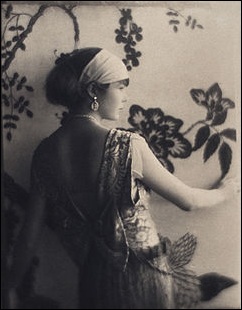
Portrait of a Woman 1920 - 1930 Baron de Meyer
But enough of dance frocks - there are other things for the busy woman of today to do. From London to Paris she flits, from there to Lido, or Deauville, and back to Scotland. Staying in town a week or so for the Little Season, then off to Leicetshire for the first cubbing. Naturally, with all this movement, her travellling outfit must be the last word in chic. If she motors she has the softest, most velvety unchrushable thing in suede that can be imagined - or for a longer journey a matching ensemble. Can 1920's fashions really be improved upon? We cannot help wondering. The world was searched for exquisite fabrics. They were woven and cut by a master hand. Artists designed them and faithful fingers executed them. Every garment ideally suited to its purpose, from the practical little morning woolly, with its little matching coat for a chilly day, a classic tailleur, enveloping top coats, luxurious furs, sinuous dance frocks and stately robes de style for more ceremonious occasions. To envelope them a luxorious evening wrap of glittering brocade and seductive fox to trim it, of which the large soft collar and cuffs are echoed in the foot-deep flounce of fur which edges the hem. The small geometrical design is suggestive of mosaic; and the large folds are indicative of the richness of the material, which is heavy without losing any of the essential suppleness of the modern women's ideal.
Periods during which fashionable people sought to express in their raiment the beauty, dignity and perhaps simplicity of the highest artistic conceptions of their time are succeeded by other periods illustrating in the main the excesses of those whose ideal was merely towards eccentric exaggeration or arresting incongruity - a rage for "smartness," divorced from any real inspiration of essential beauty. Once more, for a while, loveliness of line, the beauty of the human figure untrammelled by multiplicity of wrappings and distortion of outline, wins its grim battle with fumbling dullness or ill-judged dexterity intent on "going one better" than the mode of the day; and anon, beauty is overwhelmed by the Philistines, and the World's Wife disports herself in horrors of garb, coiffure, or complexion.